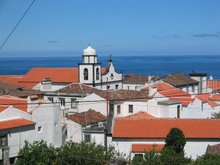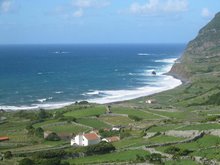This is because I'm a wee bit interested in computers but not even the most vanishingly small bit interested in cars. I'm as interested in cars as I am in electric sockets. By which I mean "I'm happy my TV works because it's plugged into an electric socket but beyond that, I just so don't want to know". Translate that to cars and it's "I'm happy we can go to Sta Cruz every second Friday after the boat's in ..." You get the picture.
This is the car ...
... and this is an electric socket
In fact, I love electric sockets 145 times more than I love my car (make that 697 times) because I don't have to take my electric sockets to be periodically inspected.
We're talking about what we Brits call the MOT Test. It stands for Ministry of Transport (although probably now rebranded "Directorate of Life Long Motive Solutions"). In Portuguese, it's the infamous inspecção.
The good thing about inspecções in Portugal is they're only every 2 years (every year in the UK) but the bad news on Flores is there isn't a full time garage that does them. Instead, the inspectores visit the island three times a year for three intensive bouts of inspecções of the vehicles due to be inspecçionados.
Imagine my lack of enthusiasm, therefore, to discover from the delphic (to put it at its highest, as we lawyers are fond of saying) notice put through the letter box a while back that our car was due to be inspecçionado in the current bout.
Having somewhat buried my head in the sand about this, I steeled myself to pull out the last test certificate the car received two years ago. Three of the faults which would involve failure at subsequent inspection if not remedied had been dealt with. But one remained for the simple reason I hadn't an effing clue what it was. Medios baixados or something.
Quick visit to a neighbour revealed it was that the headlights were aligned too high. As I've no idea how headlights are correctly aligned, I approached this by adjusting them to the lowest possible alignment on the basis that, if that would give rise to a fault to be remedied, then at least it would be a different fault.
Feeling reasonably confident, I set off for the inspecção. I had an appointment for 5.30pm but "do the math" as one of my Canadian born neighbours put it - a third of the island's vehicles had to be inspected in the course of 5 days so you're talking about roughly 100 vehicles a day. Little wonder the marcações (appointments) were running a tad em atras (f***ing late).
At around 8.45pm, I was at last waved into the inspection hall. It couldn't have been any more threatening if it had had Arbeit Macht Frei written above the door. The young man wore a white coat and his "kerb-side manner" left a little to be desired: I felt about as invaded as if it was my rectum that was about to be examined, rather than my car.
Having noted the hunted look on earlier clients' faces exiting clutching red "FAIL" notices (a number of them with much newer and posher motors than mine), my bowels lurched when the inspector wheeled up the headlight alignment testing machine. A piece of kit, all mirrors and reflectors looking like the bastard offspring of a solar power station and a microscope, I felt sure it would unmask my crude attempt at inspecção result rigging. As with all white coated torturers, however, the young man gave nothing away as he noted the result on his clip-board (actually, it was a sort of palm pilot thing beaming the results directly to the computer).
When he was all done, the chap said "You may place your car outside and then enter my office" in a "Ve have vays of making you talk" sort of accent. I was half expectng a bunch of goons in leather jackets to exact dire revenge for the headlight malarky so imagine my relief when I see Mr White Coat pulling a green "PASS" notice from the computer!
Three minor blemishes to be sorted prior to next inspecção - No mention of headlights (!) but a reversing light and a registration plate light bulb is out. That's no problem but the third one defies my limited powers of Portuguese comprehension:-
860 - Livrete - Divergencia de dimensões dos pneumaticos, sendo equivalentes
Something about a little book and a discrepancy in the dimensions of my tires being equivalent????
If there are any Portuguese speakers out there who can tell me what this is, then I'd be very grateful. I don't want to have to be thinking about it on 21 March 2012. In exchange, if anyone needs their headlights realigned, then I'm your man.





























